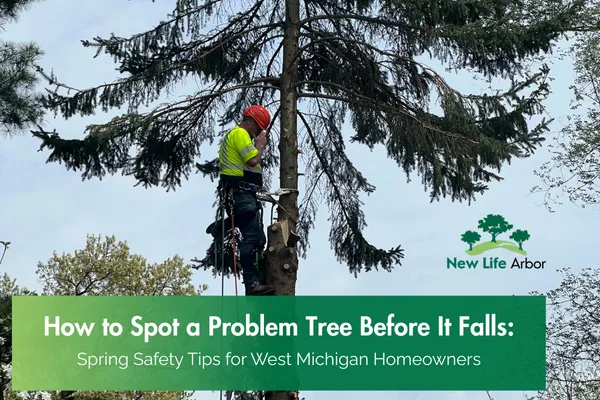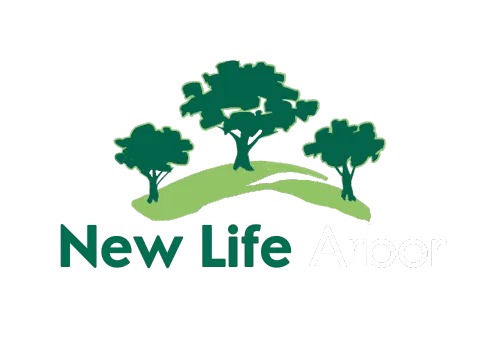
How to Spot a Problem Tree Before It Falls: Spring Safety Tips for West Michigan Homeowners
Rooted in Michigan: Deep Roots, Strong Trees
Springtime in West Michigan is a season of renewal—but it also brings windstorms, saturated soil, and the return of hidden hazards in your yard. At New Life Arbor, we believe your safety begins with your trees. So this May, let’s talk about how to spot the early warning signs of a dangerous tree before it becomes a real threat to your home, family, or neighbors.
Why Tree Safety Matters in Spring
After winter’s weight and wind, spring is when weakened trees often reveal their most dangerous flaws. Michigan’s thaw cycles and strong April winds can turn minor issues into major risks. Identifying hazardous trees early not only protects your property—it can save lives.

1. Leaning Trees: Warning or Just a Quirk?
A slight lean doesn’t always mean danger—but a sudden or increasing tilt, especially with exposed roots, is a red flag. If the soil around the base of the tree appears lifted or cracked, the tree could be uprooting.
What to do: Don’t try to correct a leaning tree yourself. Our certified arborists can assess whether the lean is structural or cosmetic.

2. Cracked or Split Trunks
Tree trunks should be solid and uniform. Deep vertical cracks, splits, or seams in the bark can indicate internal decay or damage from wind and ice.
Pro tip: Trees can look healthy on the outside but be hollow inside. A professional inspection may reveal hidden risks before a trunk failure occurs.
3. Dead Branches (Especially at the Top)
These are called “widowmakers” for a reason. Large dead branches, especially in the upper canopy, are dangerous because they can fall unpredictably.
Watch for: Brittle branches, lack of leaves in late spring, or fungi growing on limbs.

4. Mushrooms at the Base
Fungi and mushrooms growing near the roots or base of a tree often signal decay beneath the surface. This can compromise the tree’s stability from the ground up.
Warning signs: Conks (shelf mushrooms), soft wood near the trunk, or a musty smell around the base.
5. Storm Damage from the Past Winter
Even if your tree “looks okay,” past damage can lead to slow decline. Cracks that developed under snow weight or limbs weakened by ice may fail during May’s storms.
Look for: Previous wounds, jagged breaks, or branches that never recovered from the cold.

6. Unbalanced Canopy
If one side of your tree is much heavier or denser than the other, it could be at risk of tipping. This often happens when a tree grows toward light or is pruned incorrectly.
What we do: New Life Arbor offers expert pruning to safely restore balance and prevent future issues.
7. Root Issues: Often Hidden, Always Serious
Roots anchor your tree. When they’re damaged—by construction, disease, or oversaturation—your tree loses stability. Symptoms like thinning leaves, leaning, or surface root exposure suggest trouble underground.
How we help: Our team provides deep root inspections and soil evaluations to spot the invisible threats.

Why Call an Arborist Instead of DIY?
While it’s tempting to assess trees yourself, many hazards aren’t visible from the ground or to the untrained eye. That’s why West Michigan homeowners trust New Life Arbor.
We’re not just here for emergency removals—we’re your local experts in prevention. Whether it’s spotting a split trunk before it falls or preserving a mature oak with careful cabling, we offer safe, reliable solutions backed by over 20 years of experience.
What If a Tree Is Hazardous?
If our arborists determine that your tree is a danger, we’ll walk you through your options—whether it’s targeted pruning, cabling, or complete removal. And if you’re in Grand Rapids, East Grand Rapids, Forest Hills, Rockford, or any of our surrounding service areas, we can usually schedule prompt service, especially if it’s an emergency.

Spring Safety Checklist: Is It Time to Call?
🌳 Is your tree leaning more than 15 degrees?
🪵 Are large branches bare or brittle?
🍄 Are there mushrooms or fungi at the base?
🌬️ Did your property take a hit from recent storms?
🛑 Do you feel uncertain about a tree’s stability?
If you answered yes to any of these, give us a call at (616) 404-4211 or request a free inspection online at newlifearbor.com.
Stay Rooted. Stay Safe.
At New Life Arbor, safety is one of our core values. We want you and your trees to thrive, not just survive. This spring, let’s work together to prevent problems before they start—so your yard stays safe, beautiful, and deeply rooted in Michigan.





